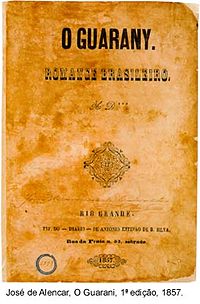- The Guarani
-
The Guarani: Brazilian Novel 
Cover of the first edition, financed by Alencar himselfAuthor(s) José de Alencar Original title O Guarani: Romance Brasileiro Translator James W. Hawes Country Brazil Language Portuguese language Publication date 1857 Published in
English1893 Media type Serial (hardcover and paperback) ISBN N/A The Guarani: Brazilian Novel (Portuguese: O Guarani: Romance Brasileiro) is a 1857 Brazilian novel written by José de Alencar. It first came out as a feuilleton in the newspaper Diário do Rio de Janeiro, but due to its enormous success Alencar decided to compile his writing in a volume. A plausible explanation for this success might be in the fact that novel spoke of freedom and independence, arguing for a nativeness that could be found in tropical Nature and in the indigenous people of Brazil.
Years later the novel was turned into an opera performed in Italian and called Il Guarany (1870), by Carlos Gomes, among other places it was presented in Milan and New York (it is a known fact[citation needed] that the author did not appreciate the final result).O Guarani is regarded a foundational text of Brazilian Romanticism, but it gained international projection by being translated into Spanish, German (Der Guarany, Brasilianischer Roman, Maximillian Emerich, 1876) and English (The Guarany, Brazilian novel, James W. Hawes, 1893).
The novel is still widely read nowadays, especially at Brazilian schools as an introduction to novel reading, but also by anyone who enjoys a thrilling adventure story. Literary criticism has tended to link O Guarani to the works of Fenimore Cooper, Chateaubriand and the noble savage from the Rousseauesque tradition. However, this interpretation of the novel has become outdated as recent academic works show also how dark, sexual and gothic the novel is.
Plot introduction
O Guarany is set back in 1604, a period when Portugal and its colonies submitted to Spanish dominion due to a lack of heirs to ascend to the throne. Alencar takes advantage of this dynastic complication to resurrect the historical figure of D. Antônio de Mariz, a nobleman connected to the foundation of the city of Rio de Janeiro and a pioneer settler. This historical (factual) background, which orients the novel throughout, is set in the first two chapters; then fantasy, both violent and erotic, starts to prevail.
D. Antônio establishes himself in a deserted inland region, a few days’ travel from the seaside city of Rio. The land was granted to him through his services to the Portuguese crown, whose legitimacy the nobleman now distrusts. To be politically independent (if not economically) and keep to the Portuguese codes of honour, he builds a castle-like house to shelter his family in Brazilian soil where he lives like a feudal lord with his family and retainers.
His family consists of his severe wife D. Lauriana, his angelic fair, blue-eyed daughter Cecília, his dandyish son D. Diogo and the ‘niece’ Isabel, a cabocla who is in fact his illegitimate daughter by an Indian woman. Other people are also attached to his household, a few loyal servants, forty adventurers/mercenaries kept for protection, the young nobleman Álvaro de Sá, an appropriate suitor for his lawful daughter Cecília, and Peri, an Indian of the Guaraní people, who once saved Cecy’s life (as the romantic/romanticised Indian endearingly calls Cecília) and who has since deserted his tribe and family. Pery is the hero who gives title to the book, he is treated as a friend by D. Antônio and Cecy and as a nuisance by Mrs. Mariz and Isabel. The life of the characters is altered by the arrival of the adventurer Loredano (former friar Angelo di Lucca) who insinuates himself into the house and soon starts subverting the other vassals, planning to kidnap Cecília and scheming against the house of Mariz.
External links
- O Guarani (Portuguese)
Categories:- 1857 novels
- Novels by José de Alencar
- Portuguese-language novels
- 1600s in fiction
- Novels set in Brazil
Wikimedia Foundation. 2010.
